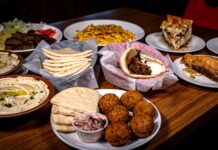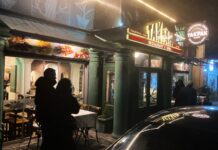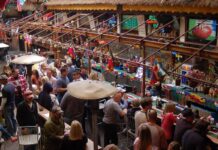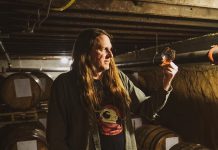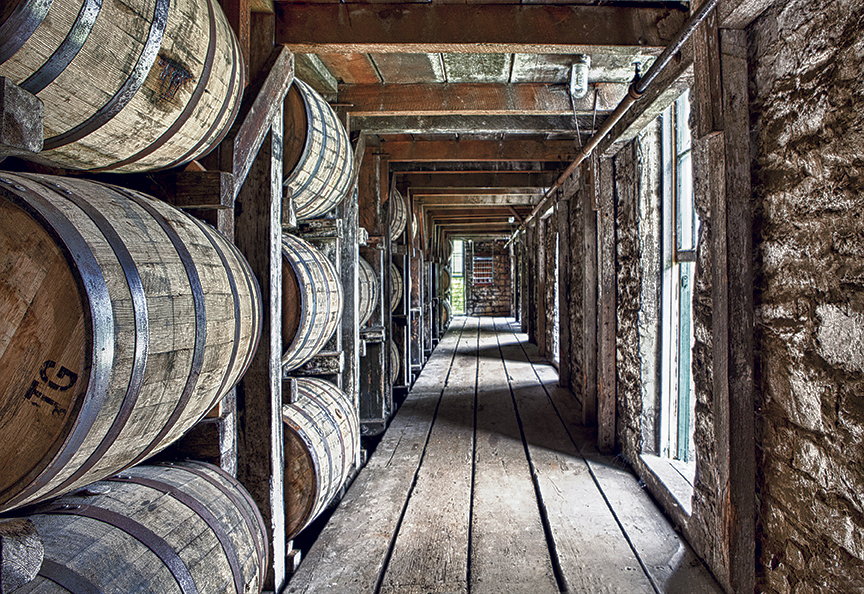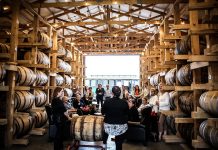With prices of single bottles being sold for thousands of dollars (both at retail and on the secondary market) Pappy Van Winkle Bourbon is an iconic brand that has transcended the bourbon world and entered into popular culture. It all started in 1996 with a score of 99 from the Beverage Tasting Institute of Chicago — the highest score ever awarded to a bourbon. Interest began to grow for the brand, and it began to make multiple national lists as “one of the best bourbons in the world.” By the time the late Anthony Bourdain was seen swigging it on his show No Reservations and calling it, “the most glorious bourbon on the face of the planet,” the interest in Pappy was at a frenzied level for bourbon and non-bourbon fans alike.
So… where in the world is the Pappy Van Winkle Tour?
It makes sense that extreme interest in the bourbon creates a demand for individuals wanting to seek out and experience firsthand how it is made. Is there a different process to making Pappy Van Winkle, giving it the unique taste? I mean, so many people are willing to pay more for a bottle than a serviceable used car. There must be something about it, and I’m sure bourbon fans would love to learn about it.
The truth is, Pappy Van Winkle is sold by Rip Van Winkle Distillery, which isn’t a distillery at all. It’s a company owned by Julian Van Winkle III, who sources his product through Buffalo Trace Distillery in Frankfort. Since Rip Van WInkle isn’t a production distillery, the company isn’t a place you can visit to see any part of the process of making what may very well be the world’s most coveted bourbon.
During my many trips to Buffalo Trace, I have witnessed very little acknowledgement of Pappy at the distillery. I found a few items in the gift shop, but you can’t buy any bottles there. It’s not part of the tasting flights, and there certainly isn’t a Pappy tour advertised. With an unquenched thirst for information about this iconic brand that almost equals the demand for the product itself, what is an education-seeking bourbon fan to do?
All hope is not lost. I’ve got a juicy little secret for you. While there isn’t a Pappy-specific tour at Buffalo Trace, there is certainly something of real interest for those who want to know more about the brand. I decided to take one of the free tours called the Bourbon Barrel Tour, which would follow a bourbon barrel through its life at the distillery.
It turns out, this tour was about much more than the life of a bourbon barrel. I felt like I found the Holy Grail of tours for bourbon fans, so cue the dramatic heavenly music.
I found the hidden Pappy Van Winkle tour.
I think there are a couple reasons Buffalo Trace refrains from billing it as such. First, if they even alluded to the fact it includes information about this highly sought bourbon, I think it would end up with an overcapacity situation for this particular offering at the expense of the rest of their tours. Secondly, it’s not truly all about Pappy. While I would love to learn more about the history of the brand and the people behind it as well as information about production and distribution, I didn’t find it here. Still, I couldn’t help by the end of my time here but to feel like I had slipped behind the curtain to gain some insight that I haven’t been able to find anywhere else.
I really happened on something special: Pappy bottling day. There isn’t really any way to time this, because they don’t promote when certain products are bottled. I just happened to get lucky and encountered a line of barrels that were rolled in a procession from a warehouse to the bottling area where they waited to be dumped, filtered and then batched and bottled. My tour guide helped determine the age of these barrels marked “W.L. Weller.” They were all 10-years-old or older, which is a clear indicator they are designated to become Old Rip Van Winkle, the 10-year-old bourbon from the Pappy Van Winkle lineup.
Let’s take a look at how I knew this.
This is so important, because, while the true bourbon aficionado probably realizes W.L. Weller and Pappy share the same mash bill, they may not understand they are literally the same product. The difference comes from what happens in the barrel. With that in mind, there is no such thing as a “Pappy Van Winkle” run at Buffalo Trace that is then barreled and designated Pappy Van Winkle bourbon when it’s fully matured.
Instead, Julian Van Winkle III and Buffalo Trace Master Distiller Harlen Wheatley taste barrels of W.L. Weller as they are maturing. Some stand out as being “superior” based on the flavor profiles. Those barrels are then flagged and destined to be one of the Pappy products. I instantly recognized the barrels lined up like a marching band as future Pappy products on that fateful day, because I know there is no such thing as a ten-year-old W. L. Weller bourbon.
I found the next tour stop to be Pappy Heaven. I was actually taken inside the warehouse where “Pappy barrels” age. (Unlike other Pappy secrets you have to piece together yourself, my guide actually told us these were designated Pappy barrels). The warehouse sits the closest on the property to the Kentucky River. Being that close to water means that it has a micro-climate different than the rest of the warehouses on the property. Buffalo Trace takes full advantage of this by having gaps in the floor, allowing steamy summer air or river-cooled winter air in to age this product differently than in any other warehouse on the property.
I walked into the ultimate rick house experience, enjoying the smell of bourbon like I would at any aging warehouse, but don’t forget. Here, I was nosing 20, 23, and 25-year-old (or more) Pappy Van Winkle bourbon. While it may cost you over $100 per pour, depending on what expression of Pappy you are drinking at a bar, these sniffs of aging Pappy were absolutely free.
Does it get any better than that as a bourbon fan?
You can see the wear and tear on the barrels in this warehouse. Those temperature fluctuations do a number on them. Many leak and look like a bourbon bomb went off very near them — in the coolest way possible. While all bourbon barrels leak, these leak that 20-year-old or more bourbon that is dark as molasses, causing incredible dark stains. The stains reminded me of those old psychology “ink blot” tests where they show patients cards with spilled ink and ask them to, “Tell me what you see.”
My response would be, “I see bourbon. Based on the cost per ounce of Pappy Van Winkle, that looks like about $740 on that barrel right there.”
The rest of the tour was informative and fun. I got to see barrels getting ready to be filled and others that needed to be repaired. I saw a team moving and dumping barrels, and I even got to hammer a bung into a freshly filled barrel of Buffalo Trace bourbon. (What a great photo op!)
This tour might not have been designed as an official Pappy tour, but chances are — if you love the brand’s legend, lore, the chase and the taste as much as me — this is as close as you will get to a Pappy tour, and it’s pretty darn great.


